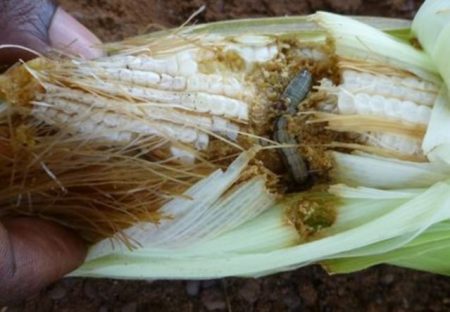February 15, 2017 – One of the consequences of greater global integration is the spread of invasive species. In Africa, already feeling the impact of a drying trend associated with climate change, staple crop producers are already feeling the effects of production declines in agricultural yields. Added to this has come an infestation of a Central and South American import, an invasive armyworm that differs from the native species found in West and Central Africa.
Armyworms are the caterpillar or larvae stage of a moth. They grow to about 4 centimeters (1.5 inches) in length during the three-week larval stage. Two weeks after they pupate they emerge as adult moths to start the cycle over again. The adult moths measure about 5 centimeters (2 inches) in wingspan and can lay up to 2,000 eggs before dying.
A species of armyworm is native to Africa. The African variety is slightly smaller than its American cousin and is partial to eating cereal crops like corn, wheat, sorghum, millet and rice, as well as pasture forage such as alfalfa. The American variety, known as the fall armyworm, has less discriminating tastes attacking about to 100 different plant species including important crops such as cotton, soybeans, peanuts and other groundnuts, potatoes, sweet potatoes, spinach, tomatoes, sweet peppers, cabbage and tobacco.
When armyworms infest a field you understand why they have been given their name. They literally march through a farm devouring everything in their path. They even consume each other when they run out of plants to eat.
What is their impact on Africa so far?
They first appeared in Nigeria and neighbouring West African states in January of 2016. Beginning last December they spread rapidly into Zambia and from there southward to South Africa. Eight countries have been infested with the biggest damage to corn (the principle staple crop of southern Africa). In Zambia, losses in corn could amount to 40% of the total crop. In Zimbabwe, seven of eight corn-producing areas are infested. In one South African farm, the owners report 80% of their corn crop damaged. The owner, Jacques Prinsloo, states, “these worms are eating everything they touch…last year the drought, this year the worms, what next year?”
The Prinsloo farm is not alone. Crops like corn, wheat, millet and rice are all under attack. When combined with the two-year drought, food availability in Africa’s richest country is expected to decrease by as much as 15%.
So what controls exist to stop them?
The most commonly used insecticides are pyrethroids. Another control is the introduction of genetically modified (GMO) corn which is resistant to armyworms. The problem with the latter is a general lack of enthusiasm on the part of African states to introduce GMO varieties. Why this is so has much to do with the relationship of African agriculture to the European Union, the latter whose prohibitions on importing GMO produce impact policy.
In the Americas, where the fall armyworm is being attacked by a combination of GMO crops and non-chemical solutions that introduce natural biological controls such as viruses, fungi and bacteria, crop damage has been lessened.
Another choice for Africa could be using local plant extracts as toxins or introducing sand dusting in corn fields during early plant growth as the leaves unfurl to act as an inhibitor. Armyworms don’t like sand.
















